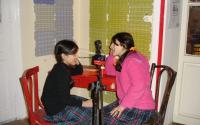6 December 2005Jonathan Amos
The block of ice resembles a wobbly tooth |
The 30km by 30km block of ice known as the "Loose Tooth" is in the process of cracking away from the eastern edge of the White Continent.
The project, led by the US Scripps Institution of Oceanography, aims to understand the mechanisms that drive the calving of great ice masses.
This information will aid researchers as they try to work out how Antarctica will respond to a warmer world.
"Icebergs account for about two-thirds of the mass lost from Antarctica, so if you want to understand how that will change if you alter the climate then you need to have this component," explained Jeremy Bassis.
The Scripps researcher was speaking here at the Fall Meeting of the American Geophysical Union (AGU).
With colleagues, he installed GPS receivers and seismometers on Loose Tooth to trace the opening of a rift that is gradually separating the block from Amery Ice Shelf.
 Little is known about the drivers of iceberg calving |
They probably do play some role, as does ocean swell, but it is not an obvious one.
"We think it comes down to the internal glaciological stress," Bassis said.
"This thing is basically like a pancake spreading out. Gravity causes stresses and it starts to crack. It's more like a geological fault: you're not flicking it to make it go; it is just that stresses build up and then it suddenly switches on."
One fascinating observation followed the big Sumatran earthquake last December.
The seismometers on Loose Tooth picked up the signal and within a day, the crack had moved again - although there is no way to positively connect the two events.
Loose Tooth is expected to fall off Amery Ice Shelf in the next five years.
The project was led by Helen Amanda Fricker at Scripps and Richard Coleman at the University of Tasmania, Australia







